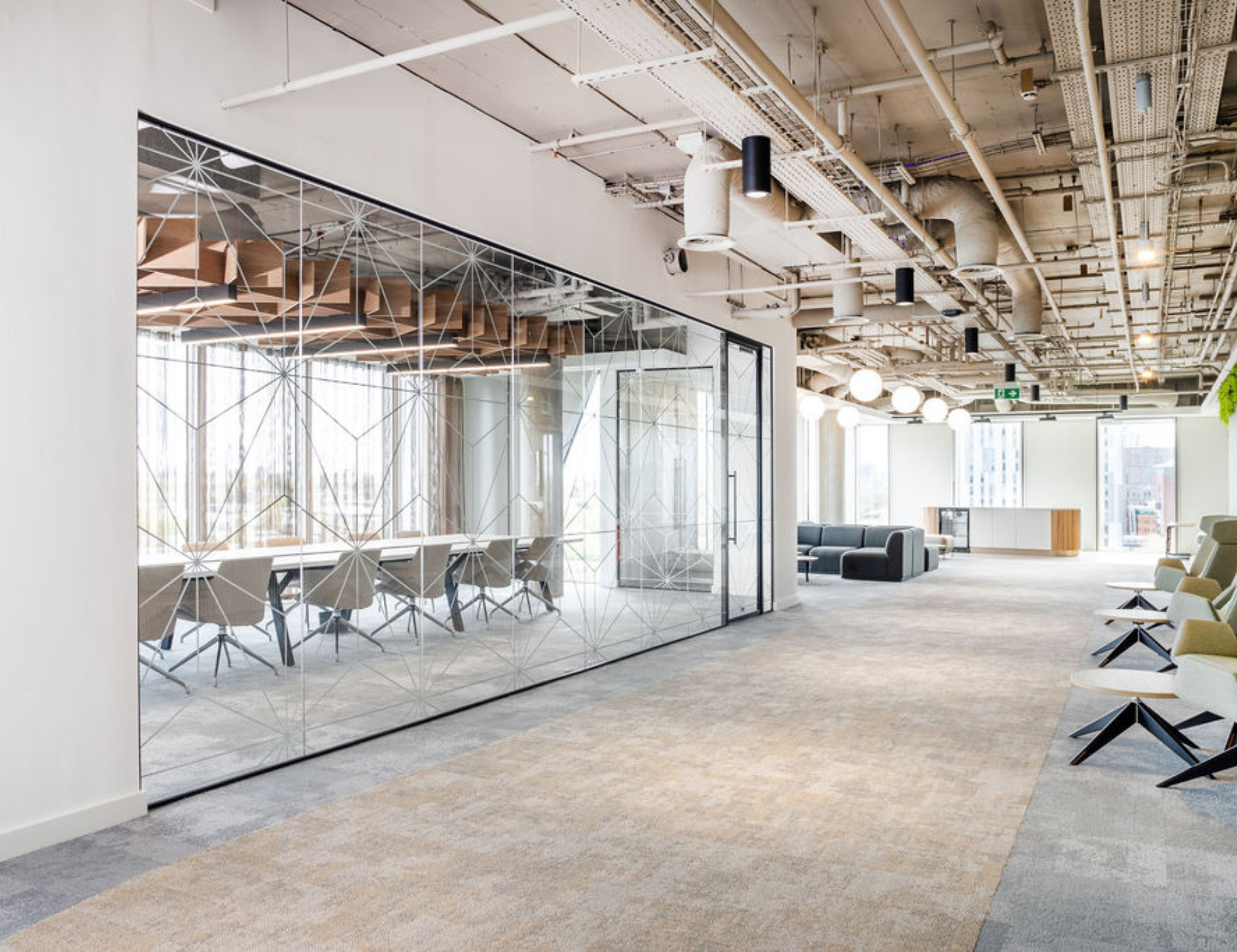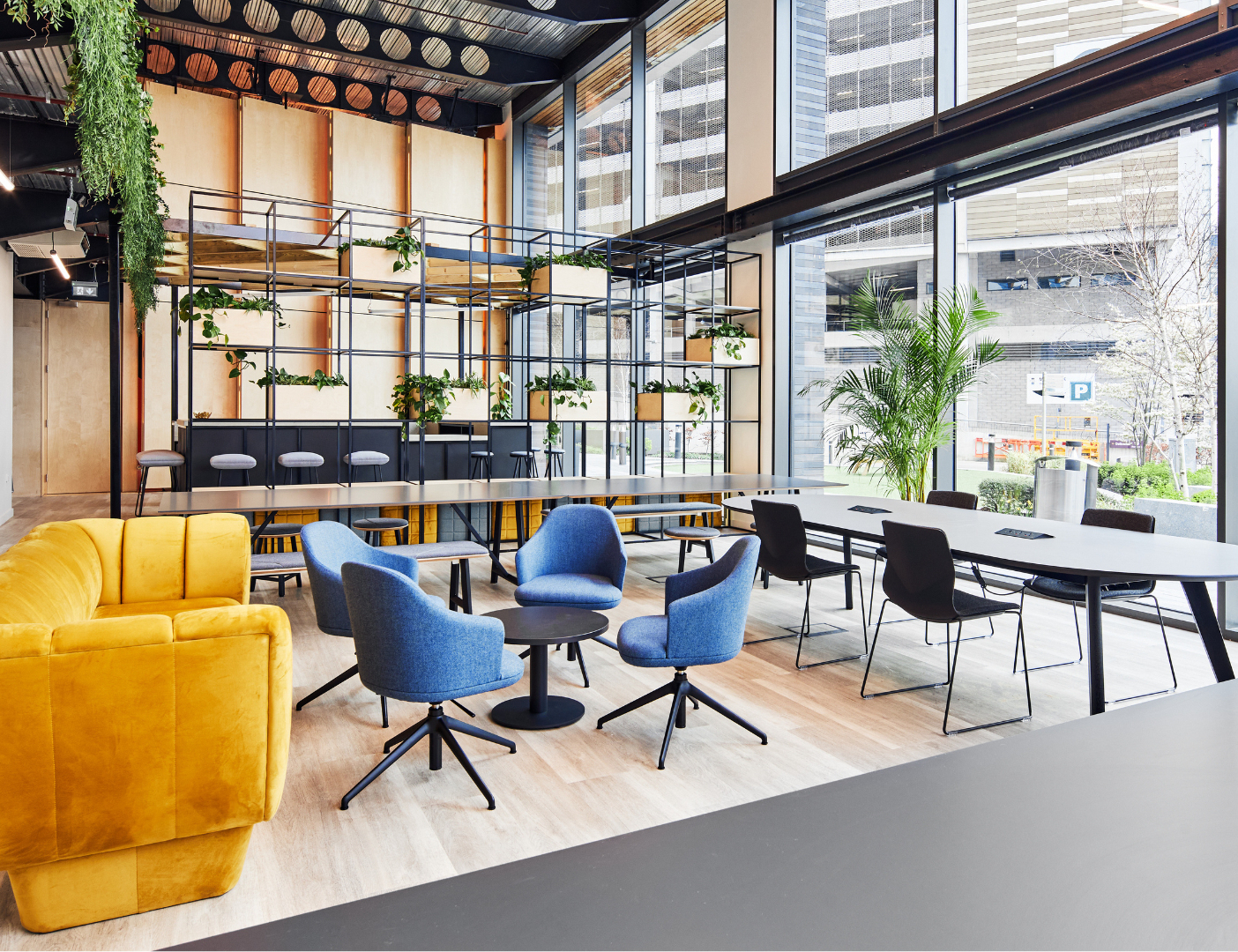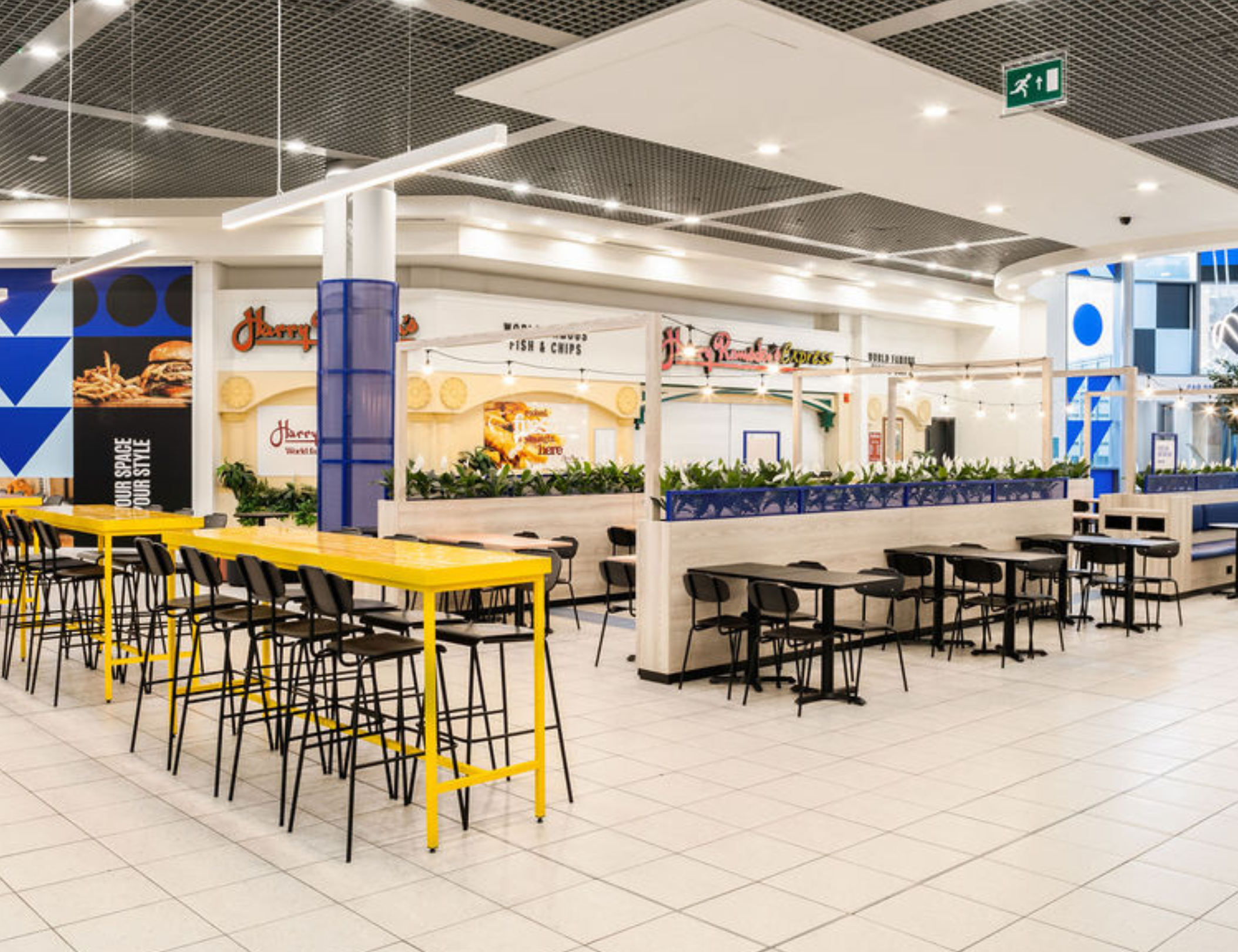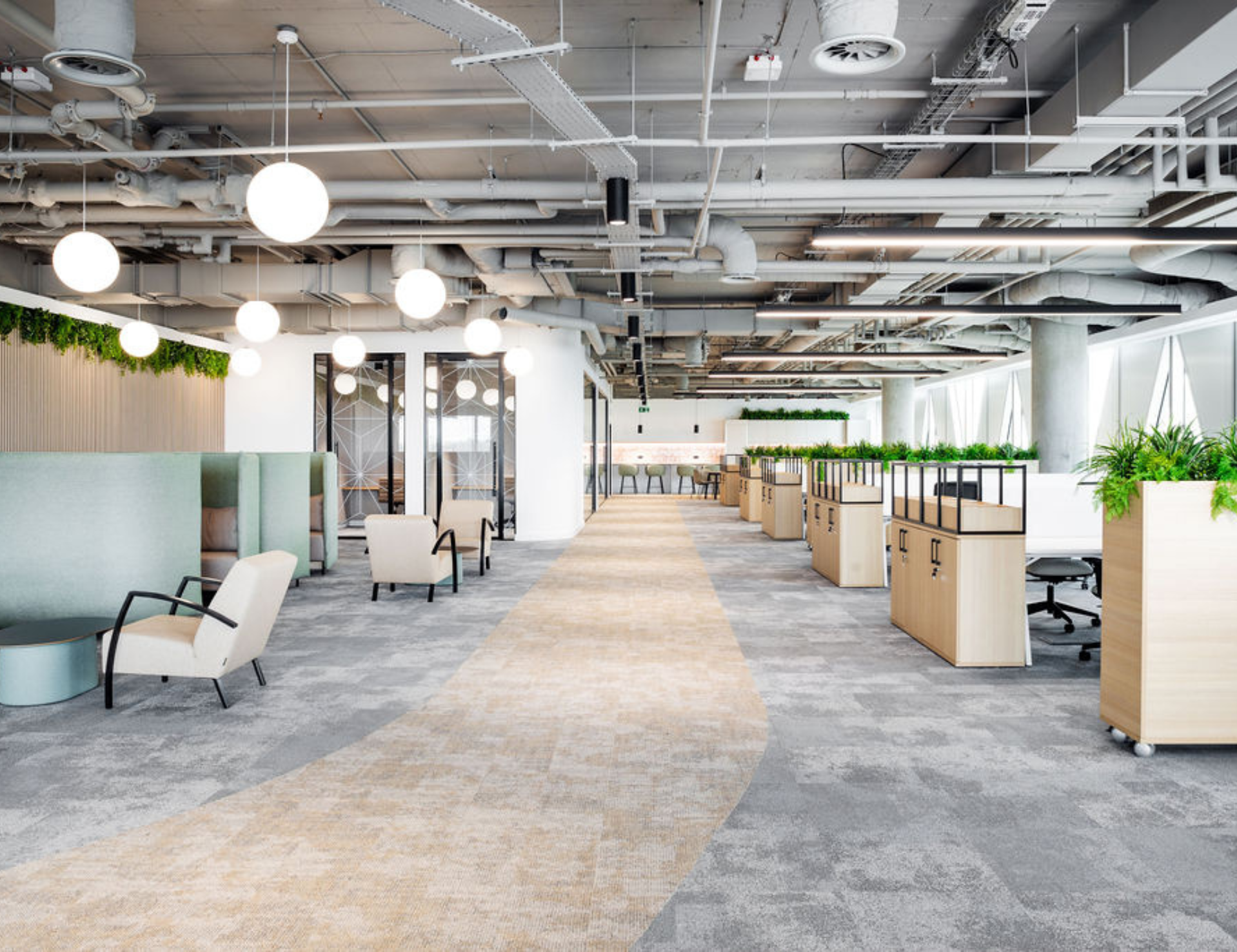The modern workspace is evolving rapidly, with companies reimagining office environments to align with new priorities such as flexibility, collaboration, sustainability, and employee wellness. As businesses look to refurbish or fit out their offices, understanding the latest office interior design trends is crucial. These trends not only foster a productive and inspiring environment but also reflect a company’s values and culture. 97% of survey respondents stated that they regard their workplace as a symbol of whether or not they are valued by their employer. Here are the top office interior design trends for 2024.
Hybrid Workspaces
The shift towards hybrid work models has been significant since the pandemic. According to a 2023 McKinsey survey, over 90% of organisations are now combining remote and on-site work. This trend necessitates a balance between collaborative in-person teamwork and providing amenities for employees who split their time between home and the office. Office designs now include features such as ‘Zoom Rooms’ for virtual meetings, touchdown spaces for remote workers, hot-desking options, and technology that facilitates hybrid collaboration. The office remains a hub for connection, innovation, and culture, while also offering the flexibility that employees have come to expect.

Biophilic Design
Biophilic design, which integrates natural elements into the built environment, has become increasingly popular. This trend involves maximising natural light, incorporating greenery, and using organic patterns and materials. Elements such as living walls, green roofs, courtyards, and nature-inspired artwork are common. Research shows that biophilic design can boost productivity, creativity, well-being, and employee satisfaction. It taps into our innate connection with the natural world, creating a vibrant and inspiring workspace that also allows for unique branding and aesthetics.

Technology Integration
The integration of smart technology in office design is transforming workspaces into intelligent, responsive environments. Features include occupancy sensors, smart LED lighting, temperature control systems, and interactive screens for seamless collaboration. Apps for controlling space booking, amenities, AV equipment, and voice assistant technologies like Alexa for hands-free control are also becoming standard. This technology not only provides data insights but also allows workspaces to respond dynamically to evolving needs, optimising efficiency and creating personalised employee experiences.

Flexible and Modular Spaces
Gone are the days of rigid cubicles and assigned desks. Today’s offices are designed to be flexible and adaptable. Modular furniture systems, moveable walls, acoustic dividers, and multi-use furnishings allow companies to reconfigure layouts and create collaborative zones easily. This fluid design approach supports diverse work modes—collaboration, focus, learning, socialising, or rejuvenating—and caters to the natural ebb and flow of office-based work. Employees are empowered to choose their work settings, and spaces can be modified to suit changing team dynamics and needs.

Sustainability and Eco-friendly Practices
Sustainability is a key priority for companies aiming to reduce their carbon footprint. Offices are becoming greener through operational energy efficiency, renewable energy solutions, and sustainable building materials. Practices include responsible waste disposal and recycling programs, low-emission paints, furniture and flooring made from non-toxic materials, and motion-activated lighting to reduce energy waste. Green retrofits have shown significant benefits, including up to 11% gains in productivity from improved ventilation and up to 23% from improved lighting design. Such eco-friendly practices not only benefit the environment but also enhance a company’s brand image.

Mental Health and Wellbeing Focus
Employee mental health and well-being are paramount. A report by the American Psychological Association (APA) highlights that 92% of workers value working for an organisation that supports their emotional and psychological well-being . Office designs are increasingly incorporating elements that promote mental health, such as private spaces for relaxation or quiet focus, access to natural light and greenery, ergonomic furnishings, and amenities like gyms or walking trails. Creating a workspace that fosters happiness, reduces stress, and supports overall well-being can significantly enhance the daily experience for employees.

Colour Psychology and Aesthetics
The strategic use of colour in office design can significantly impact mood and motivation. Bright, vibrant tones can energise, while warm neutrals promote relaxation and focus. Cool hues like blue or green have a calming effect. By playing with different textures, artwork, and furnishings, companies can enhance creativity and incorporate their brand identity into the office’s look and feel. A well-designed colour palette creates an inviting, branded environment where employees enjoy working and connecting.

Multi-functional Spaces
The modern office is no longer just a place for work; it is an all-encompassing environment that supports work-life balance. Offices are integrating amenities that allow for rejuvenation and recreation alongside work. Features such as gyms, nap pods, massage rooms, games lounges, cafes, outdoor spaces, and even “speakeasy” bars or hidden lounges provide opportunities for movement, relaxation, and fun. Quiet libraries or meditation rooms offer spaces for calm reflection. These multi-functional spaces support employee well-being and foster a sense of community.

Inclusive Design
Diversity, equity, and inclusion are integral to modern office design. Offices must cater to a diverse workforce by being accessible and inclusive. This includes ADA compliance, gender-neutral spaces, prayer rooms, ergonomic furniture for all body types, and signage in multiple languages. Providing a variety of work settings ensures that all employees feel accepted, valued, and able to thrive. Inclusive design is not only the right thing to do but also smart business, as diverse companies are more successful at attracting top talent and outperform industry norms by 36%.

Local Culture and Brand Integration
Leading companies are integrating local culture and their brand identity into office designs. This trend celebrates the city or country’s heritage and fosters a sense of community. Examples include murals or artwork from local artists, reclaimed woods or local natural materials, and architectural details reflecting regional history. Additionally, custom signage, display walls showcasing products or achievements, and branded colour schemes tie the workspace to the company’s values and identity. A well-integrated office design creates a welcoming environment that employees can take pride in.

As work dynamics continue to evolve, so will office spaces. By keeping these 2024 office interior design trends in mind, companies can craft personalised environments that unlock productivity, creativity, and purpose. The office remains an irreplaceable epicentre for community, innovation, and culture, and the latest design trends aim to maximise its positive impact. For businesses looking to stay ahead of the curve, embracing these trends will not only enhance the workplace experience but also demonstrate a commitment to the well-being and satisfaction of their employees.
For more insights and assistance in bringing these office design trends to life, reach out to our team of experts at Consensus Workspace. We’ll collaboratively transform your workspace vision into an inspired reality. For comprehensive office fit-out services, explore our office fit-out solutions. If you need expert advice on optimising your workspace, our workplace consultancy services are here to help. Most relevantly, our office design services can be seen here.
By implementing these trends, companies can ensure their office spaces not only meet the demands of the modern workforce but also reflect their commitment to creating a supportive, dynamic, and inclusive environment.
